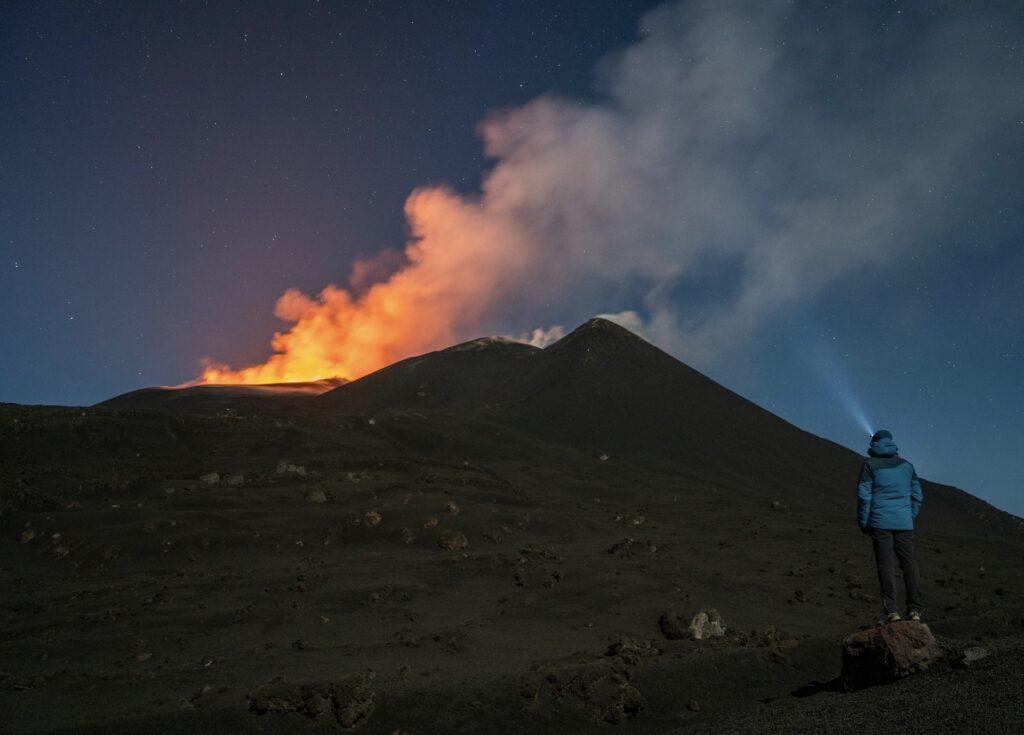Mount Etna is one of the most active volcanoes in the world and is located on the east coast of Sicily, Italy. The Voragine crater is one of the four main summit craters of Etna, together with the Northeast crater (NEC), the Bocca Nuova crater (BN) and the Southeast crater (SEC). The eruptions at Voragine crater are particularly spectacular and deserve special attention due to their complexity and intensity.
The most recent eruptive activity at Etna’s Voragine crater is described in detail below:
Geological context
The Voragine crater, also known as the ‘central crater’, was formed in 1945 and has played an important role in Etna’s eruptions over the years. This crater is known for explosive eruptions and the emission of ash and volcanic gases.
Last eruptive activity (June-July 2024)
Etna’s last eruptive activity at Voragine crater began in June 2024 and continues to show signs of activity.
Detailed chronology:
Start of the activity (June 2024)
Start date: The activity was first reported on 5 June 2024
Pre-eruptive signals: In the previous days, the INGV (National Institute of Geophysics and Volcanology) registered an increase in seismic activity, indicating subsurface magma movements and a localisation of the source of the tremor in the Voragine crater.
Strombolian activity
Description: The eruption began with Strombolian activity characterised by intermittent explosions and the ejection of lava shreds and volcanic bombs. Utilisation of the summit area was guaranteed despite the eruptive activity.A kind of ‘tourist eruption’, at least at the beginning!
Development of the eruptive activity (June/July 2024)
In July, the Strombolian activity continued with a series of smaller explosions and then culminated in lava fountains with a series of 4 paroxysms (so far!) that filled the Bocca Nuova crater with lava until the lava flow overflowed from the north-eastern wall.
Gaseous emissions: The emission of gases such as sulphur dioxide (SO2), detected by the satellite monitoring instruments and contributing to the formation of volcanic clouds, was also significant.
Observations and monitoring
Technology used: INGV used drones to obtain detailed thermal images of the crater, while seismic and GPS stations monitored ground deformations.
Environmental impact
Ash deposits: Ashfall mainly affected the eastern and south-eastern sectors of Etna, with significant accumulations in the municipalities of Milo and Fornazzo.
Air quality: The increase in SO2 emissions had a temporary impact on air quality.The situation was different with the dust raised on the roads by cars and motorbikes; the Piedmontese municipalities were forced to carry out compulsory shifts to ensure the removal of the fallen volcanic ash.
Safety measures
Evacuations and restrictions: Access to the summit areas has been prohibited to the public for safety reasons and the Civil Defence management and prevention system ensures that it is safe to move at lower altitudes even during eruptive activity.
Warnings for air traffic: Catania Airport has introduced safety protocols and is constantly monitoring the ash clouds with meteorological radar.
Conclusions
The last eruptive activity at Etna’s Voragine crater in June-July 2024 was and is a complex and dynamic event that requires constant monitoring by experts.this type of activity is typical of Etna, a volcano with a long history of eruptions that have shaped the landscape and affected the lives of local communities.
The eruption is a reminder of the power of nature and the importance of adequate preparation to minimise volcanic risks.
Tour variegato sul versante nord dell’Etna
Scoprite enormi crateri laterali, colate laviche vecchie e nuove e una grotta formatasi durante un’eruzione.
Valle del Bove e Grotta di Serracozzo
Escursione ai margini della Valle del Bove e visita a una delle più belle gallerie laviche dell’Etna. Si può correre in discesa sulla morbida sabbia lavica come sulla neve.
Scopriamo tutto ciò che l’Etna ha da offrire
A quasi 3.000 metri, ci troviamo proprio di fronte ai crateri sommitali. Sotto di noi si trova la Valle del Bove, un enorme deserto di lava. Camminiamo lungo i bordi del cratere e scopriamo un tunnel di lava.
La cima del vulcano attivo più alto d’Europa
A oltre 3300 metri di altezza, ci affacciamo direttamente sul cratere principale dell’Etna. Un tour per gli amanti dello sport in cerca di avventura.

